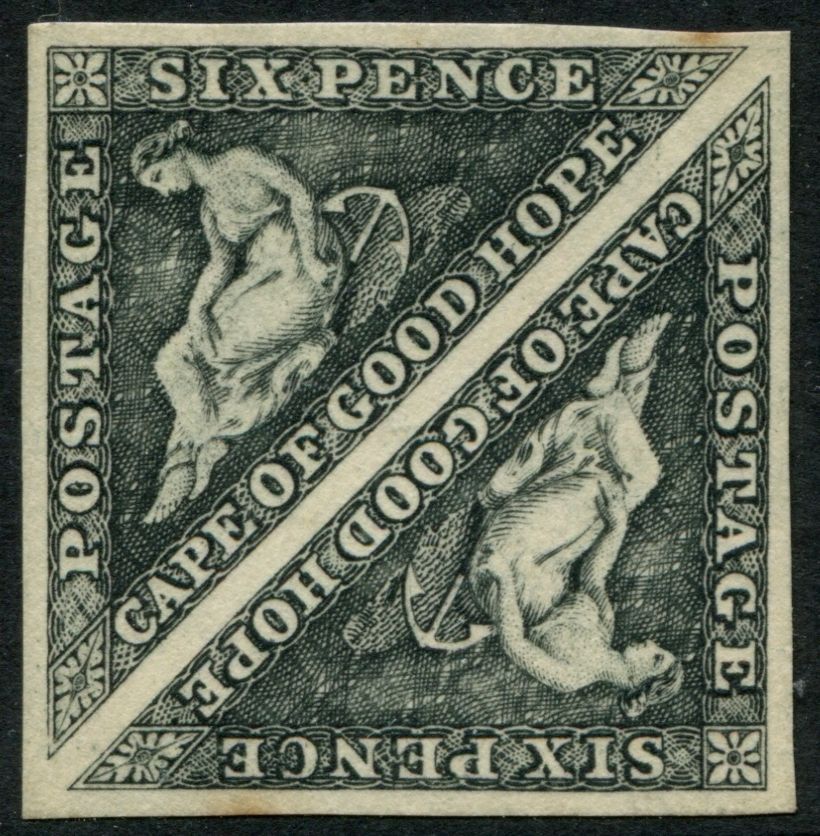 |
|||||
|
|||||
| Preview of Stamps Catalogue: VOLUME 1 |
 |
|||||
|
|||||
| Preview of Stamps Catalogue: VOLUME 1 |
Return To Catalogue - Cape of Good Hope, triangular issues, forgeries - Cape of Good Hope, triangular issues, forgeries of the woodblock issue - Cape of Good Hope other issues - Cape of Good Hope miscellaneous - Cape of Good Hope cancels - South Africa
Note: on my website many of the
pictures can not be seen! They are of course present in the catalogue;
contact me if you want to purchase it.
1 p red 4 p blue 6 p lilac 1 Sh green
For the specialist: Three different printings were made, the first one in 1853 by Perkins, Bacon & Co, the second one locally poorly printed (wood-block print) in 1861. Finally the third printing was done by De la Rue & Co in 1863, it can be distinguished by the slightly different colours and slightly sharper impression. The first and third printings have watermark 'anchor' (a 1 p red with watermark 'CC' was prepared, but not issued). The second printing has no watermark.
Front and backside of a 6 p stamp with 'anchor' watermark.
Examples of the second wood-block printing:
This 'woodblock' print became necessary, because a shipment of stamps from Great Britain was late. The woodblock stamps are quite rare. There exist errors of these stamps in the wrong colours: 1 p blue and 4 p red, (one cliche of each stamp ended up in the wrong plate) example:

(Misprint, 4 p red, genuine, reduced size)
The woodblock print has been reprinted in darker colours with watermark 'CC Crown' in march 1883 (on wove paper). Even postally used reprints seem to exist. The errors were not reprinted. Some other private reprints were made in 1940 on thick paper in again very dark colours. According to http://en.wikipedia.org/wiki/Adrian_Albert_Jurgens, Adrian Albert Jurgens was responsable for this latest (illegal) reprint. An article in the South African Philatelist of 1941 should have more details. An image of such 1940 reprints can be found at http://www.stampdomain.com/country/southafrica/display.htm.
Value of the stamps |
|||
vc = very common c = common * = not so common ** = uncommon |
*** = very uncommon R = rare RR = very rare RRR = extremely rare |
||
| Value | Unused | Used | Remarks |
First printing (1853) |
|||
| 1 p | RR | RR | |
| 4 p | RR | R | |
| 6 p | RRR | RR | |
| 1 Sh | RRR | RRR | |
| Third printing (1863) | |||
| 1 p | RR | RR | With watermark CC Crown: RRR |
| 4 p | RR | R | |
| 6 p | RR | RR | |
| 1 Sh | RRR | RRR | |
| Woodblocks (second printing, 1861) | |||
| 1 p | RRR | RRR | |
| 4 p | RRR | RRR | |
In the genuine stamps the background lines form a
cross-like structure before the 'P' of 'POSTAGE' (except for the
woodblocks).
For examples of Cape of Good Hope,
triangular issues, forgeries of the normal issue, click here.
For examples of Cape of Good Hope,
triangular issues, forgeries of the woodblock issue, click here.

Reprints made around 1929 in black.
The first reprints were made in March 1883, by Saul Solomon & Co. The colors are brighter than in the originals.

1883 reprints.
Reprints printed from the block made by the Cape Times Ltd., from a direct print from the original plates in the South African museum, Cape Town, to illustrate the Cape Woodblock Issue in the 'Handstruck Letter Stamps and Postmarks of the Cape of Good Hope 1792-1910". Note the very thin defacing line across the center of each stamp:






Another(?) set of reprints by Jurgens from 1940. Before the
plates were given back to the museum some black reprints were
made in 1941 (with larger defacing lines).
Jurgens also used (as a joke?) real cancelling devices from Cape of Good Hope, Orange Free State and Transvaal on stamps of the 1940's (I've seen South Africa and Ireland) and he also made fake Transvaal Queen Victoria bisects.

Another reprint from this museum, now in black, made in 1927.